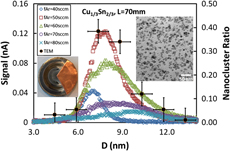Crossref Citations
This article has been cited by the following publications. This list is generated based on data provided by
Crossref.
Al Dosari, Haila M.
and
Ayesh, Ahmad I.
2013.
Nanocluster production for solar cell applications.
Journal of Applied Physics,
Vol. 114,
Issue. 5,
Ayesh, Ahmad I.
Ahmed, Haya A.
Awwad, Falah
Abu-Eishah, Samir I.
and
Mahmood, Saleh T.
2013.
Mechanisms of Ti nanocluster formation by inert gas condensation.
Journal of Materials Research,
Vol. 28,
Issue. 18,
p.
2622.
Mondal, Shyamal
and
Bhattacharyya, S. R.
2014.
Performance of a size-selected nanocluster deposition facility and in situ characterization of grown films by x-ray photoelectron spectroscopy.
Review of Scientific Instruments,
Vol. 85,
Issue. 6,
Ayesh, Ahmad I.
Mahmoud, Saleh T.
Ahmad, Sadiqa J.
and
Haik, Yousef
2014.
Novel hydrogen gas sensor based on Pd and SnO2 nanoclusters.
Materials Letters,
Vol. 128,
Issue. ,
p.
354.
Ayesh, A. I.
Mahmoud, S. T.
Qamhieh, N.
and
Karam, Z. A.
2014.
Investigation of Charge Transport in Percolating Network of PdCu Nanoclusters.
Acta Metallurgica Sinica (English Letters),
Vol. 27,
Issue. 1,
p.
156.
Ayesh, Ahmad I.
Karam, Zainab
Awwad, Falah
and
Meetani, Mohammed A.
2015.
Conductometric graphene sensors decorated with nanoclusters for selective detection of Hg2+ traces in water.
Sensors and Actuators B: Chemical,
Vol. 221,
Issue. ,
p.
201.
Ayesh, Ahmad I.
2016.
Metal/Metal-Oxide Nanoclusters for Gas Sensor Applications.
Journal of Nanomaterials,
Vol. 2016,
Issue. ,
p.
1.
Laskin, Julia
Johnson, Grant E.
and
Prabhakaran, Venkateshkumar
2016.
Soft Landing of Complex Ions for Studies in Catalysis and Energy Storage.
The Journal of Physical Chemistry C,
Vol. 120,
Issue. 41,
p.
23305.
Haija, Mohammad Abu
Ayesh, Ahmad I.
Ahmed, Sadiqa
and
Katsiotis, Marios S.
2016.
Selective hydrogen gas sensor using CuFe2O4 nanoparticle based thin film.
Applied Surface Science,
Vol. 369,
Issue. ,
p.
443.
Zinovev, Alexander
Moore, Jerome F.
Baryshev, Sergey V.
Schultz, J. Albert
Lewis, Ernest
Brinson, Bruce
McCully, Michael
and
Pellin, Michael
2017.
Laser Ablation of Sub-10 nm Silver Nanoparticles.
The Journal of Physical Chemistry C,
Vol. 121,
Issue. 17,
p.
9552.
Ayesh, Ahmad I.
Abu Haija, Mohammad
Shaheen, Adel
and
Banat, Fawzi
2017.
Spinel ferrite nanoparticles for H2S gas sensor.
Applied Physics A,
Vol. 123,
Issue. 11,
Johnson, Grant E.
and
Laskin, Julia
2017.
Gas‐Phase Synthesis of Nanoparticles.
p.
79.
Said, Khadija
Ayesh, Ahmad I.
Qamhieh, Naser N.
Awwad, Falah
Mahmoud, Saleh T.
and
Hisaindee, Soleiman
2017.
Fabrication and characterization of graphite oxide – nanoparticle composite based field effect transistors for non-enzymatic glucose sensor applications.
Journal of Alloys and Compounds,
Vol. 694,
Issue. ,
p.
1061.
Ayesh, Ahmad I.
2017.
Production of metal-oxide nanoclusters using inert-gas condensation technique.
Thin Solid Films,
Vol. 636,
Issue. ,
p.
207.
Liao, Ting-Wei
Yadav, Anupam
Hu, Kuo-Juei
van der Tol, Johan
Cosentino, Salvatore
D'Acapito, Francesco
Palmer, Richard E.
Lenardi, Cristina
Ferrando, Riccardo
Grandjean, Didier
and
Lievens, Peter
2018.
Unravelling the nucleation mechanism of bimetallic nanoparticles with composition-tunable core–shell arrangement.
Nanoscale,
Vol. 10,
Issue. 14,
p.
6684.
Ayesh, Ahmad I.
2018.
Size-selected fabrication of alloy nanoclusters by plasma-gas condensation.
Journal of Alloys and Compounds,
Vol. 745,
Issue. ,
p.
299.
Said, Abdul Rehman
Said, Khadija
Awwad, Falah
Qamhieh, Naser N.
Mahmoud, Saleh T.
Meetani, Mohammed A.
Tariq, Saeed
and
Ayesh, Ahmad I.
2018.
Design, fabrication, and characterization of Hg2+ sensor based on graphite oxide and metallic nanoclusters.
Sensors and Actuators A: Physical,
Vol. 271,
Issue. ,
p.
270.
Jalal, Viyan J.
Abdullah, Omed Gh.
and
Abdulkareem, Sarkew S.
2019.
Numerical analysis of heat removal from gas phase clusters during condensation of Cu nanoparticles under Ar atmosphere.
Results in Physics,
Vol. 13,
Issue. ,
p.
102287.
Praveen, S. G.
Bansal, C.
and
Nagar, D. Jaiswal
2019.
Inter-cluster separation induced change in charge transport mechanism in Ni40Pd60 nanoclusters.
Scientific Reports,
Vol. 9,
Issue. 1,
Haija, Mohammad Abu
Basina, Georgia
Banat, Fawzi
and
Ayesh, Ahmad I.
2019.
Adsorption and gas sensing properties of CuFe2O4 nanoparticles.
Materials Science-Poland,
Vol. 37,
Issue. 2,
p.
289.



